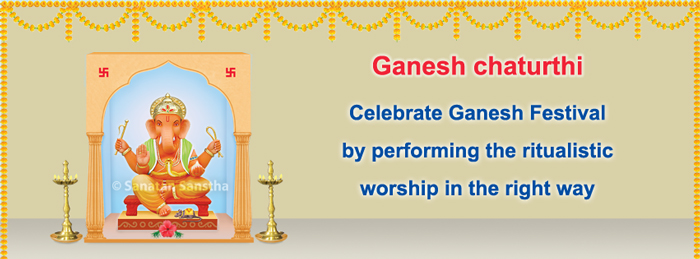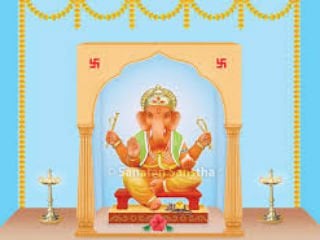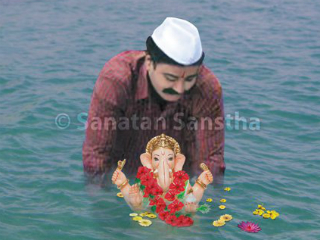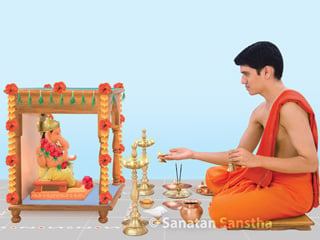
Duration of the rituals according to the scriptures and local customs
‘Idol of Shri Ganapati is sculpted from mud on Bhadrapad Shukla Chaturthi. According to the ritual mentioned in the scriptures, it is to be placed on the left palm, consecrated there itself with the Name ‘Siddhivinayak’ and immediately immersed in flowing water. However, some people who love festivities were not satisfied with such limited celebration; hence, they started keeping Shri Ganapati Idol for one and a half, five, seven or ten days and celebrating during this period. Many people have even started to immerse Shri Ganapati along with Gouri (Jyeshtha). As per the family tradition, if Shri Ganapati is worshipped for five days and if we wish to change it to one and a half or seven days, we can do so. We need not ask an authority on scriptures about this. According to the custom, Shri Ganapati Idol should be immersed in flowing water on the first, second, third, sixth, seventh or tenth day.
Installation of the Idol on the seat
Before commencing the ritualistic worship, rice (any other food grain if rice not available) is spread over the seat and then the Idol is placed on it. A fistful or a small mound of rice is used depending on the local custom. The benefit obtained by installing the Idol on rice grains is given ahead.
After invoking Shri Ganapatitattva (Shri Ganapati Principle) into the Idol and performing the ritualistic worship, energy is created in the Idol. The rice on which the Idol is placed gets charged with this energy. If two stringed musical instruments of the same frequency are placed side by side and sound is generated in one, the same sound is resonated by the other too. Similarly, generation of vibrations of Shakti in the rice kept below the Idol results in generation of vibrations of Shakti in the rice stored in the house, too. Thus, rice grains charged with Shakti can be consumed as Prasad (Holy sacrament) throughout the year.
Rituals before the main ritualistic worship and their significance
While performing each of the following rituals, a specific mantra of each ritual is recited.
1. Achaman (Sipping water from the right palm after pronouncing the 24 Names of Shrivishnu) : This brings about internal purification.
2. Desh-kal-kathan : Pronounce the name of the country and time-period.
3. Sankalpa (Resolve) : It is difficult to derive the benefit of a ritual without making a sankalpa.
4. Asan-shuddhi (Purification of the seat) : This is done by touching the seat and paying obeisance.
5. Shri Ganapatipuja : Shri Ganapati should be invoked on a coconut or a betel nut and be worshipped ritualistically.
6. Purush-sukta nyas : Amidst recitation of the Purush-sukta, the Deity should be invoked in the heart, head, shikha (A tuft of hair left on the crown of the head after tonsure), face, eyes and between the eyebrows. This helps augment the Sattva component.
7. Kalashapuja (Worship of the pot) : All Deities, seas, Holy rivers etc. should be invoked in the pot and gandha, flowers and akshata should be offered to it. This sattvik water is then to be used in the ritualistic worship.
8. Shankhapuja (Worship of the conch) : The conch should be washed and filled with water. Then gandha and white flowers should be offered to it. We should not offer akshata and tulsi leaves to it.
9. Ghantapuja (Worship of the bell) : To welcome the Deities and drive away the demons, ring the ghanta (Bell). The bell should be washed, placed to the worshipper’s left and gandha, flowers and akshata should be offered to it.
10. Deep-puja (Worship of the lamp) : Gandha and flowers should be offered to the lamp.
11. Matoli : Matoli fastened above Shri Ganapati should be worshipped by offering gandha, flowers and akshata to it. (Raw fruits, roots etc. are hung from the ceiling in front of the Idol, which is called Matoli in Goa, Bharat.)
12. Pavitrikaran (Purification) : Take some water from the conch onto the right palm and sprinkle it over yourself and the implements used during the puja.
13. Dwarpuja (Worship of the entrance) : Take flowers and akshata in your hand and scatter them in all the four directions. This is worship of Dikpal, the guardian Deities of the directions.
14. Pranapratishtha (Consecration of the Idol) : Place the right hand over the heart of the Idol of the Deity and recite the mantra. Consecration of an Idol is done on Shri Ganesh Chaturthi or to awaken any new Idol. This is not included in the day-to-day ritualistic worship since the God Principle is already present in it due to regular worship.
15. Dhyan (Meditation) : Recite the mantra, ‘Vakratunda mahakaya.. (वक्रतुंड महाकाय)’.
16. Avahan (Invocation) : At the time of invoking, recite the mantra, ‘Om sahastrashirsha Purushaha…. (ॐ सहस्रशीर्षा पुरुषः)’ and offer akshata. The akshata helps attract the Principle of the Deity faster.
17. Asan (Seat) : Offer akshata to the seat.
18. Padya (Holy feet) : To wash the Deity’s Holy feet, sprinkle water on the Idol’s feet with flowers or durva.
19. Arghya : Take a spoonful of water, add gandha to it and sprinkle that water on the Idol with a flower. This is akin to welcoming guests by sprinkling rose water on them.
20. Achaman : Considering that the Deity is performing achaman, take water in an offering spoon and offer it to Deity.
21. Snan (Ablution for cleansing of the body) : We should bathe the Deity by pouring water using an offering spoon.
Note : For clay Idol of Shri Ganapati, sprinkle water on the Idol with a flower or durva having a bhav of actually bathing Shri Ganapati in subtle.
22. Panchamrutsnan (Bathing with the five nectars) : First bathe the Idol with panchamrut (milk, honey, curd, ghee and sugar – in this sequence). Each time, take water in an offering spoon and bathe the Idol with water. Thereafter, pour three spoons of water to symbolise performing of achaman, and finally, offer gandha, flowers and akshata.
Note : For shadu Idol of Shri Ganapati, follow the same sequence of offerings with only change that instead of bathing the Idol, various components should be sprinkled on the Idol with a flower or durva having a bhav of actually offering these components to Shri Ganapati in subtle.
23. Purvapuja (Ritualistic worship before the main worship) : After worship with gandha, flowers (red flowers for Shri Ganapati), akshata, frankincense and a lit lamp; the remaining panchamrut should be used as Naivedya. To make this offering, make a mandal with water (pour some water and make a square with the water) in front of the Idol and place the panchamrut on it. (The mandal prevents energies other than the Deity’s from partaking of the offering.) There are two methods of offering Naivedya to Deities.
Method 1 – As per karmakanda
After sprinkling water on the Naivedya with two tulsi stalks with two leaves each, place one tulsi stalk on the Naivedya and offer the other at the feet of the Deity. Reciting the mantra ‘Pranaya Swaha…..’, take the fragrance of the Naivedya to the Deity with the tips of the fingers of the right hand. The science in this act is as follows – Since the waves of the five Cosmic Principles are generated by the five fingers, we are able to get, at the same time, the waves of that particular Deity in the universe associated with the five Principles.’ (Divine Knowledge received through the medium of Sanatan’s seeker H.H. (Mrs.) Anjali Gadgil, 2nd January 2005, 10.37 p.m.)
Method 2 – At the level of spiritual emotion
Sprinkle water on the Naivedya with two stalks of tulsi leaves as mentioned above, place one tulsi stalk on the Naivedya and offer the other at the feet of the Deity. Then reciting the mantra
‘Pranaya Swaha…..’, offer the Naivedya to the Deity.
As a concluding part of worship, water should be poured over the hand into the tamhan thrice, to signify washing of hands and the mouth. A flower dipped in gandha should be offered to Shri Ganapati. Betel leaves with betel nut should be placed in front of the Deity and water poured over them. We should offer flowers and pay obeisance and then release water into the tamhan.
24. Abhishek (Consecration by sprinkling with water) : After the Purvapuja, abhishek is performed while reciting the Atharvashirsha or Brahmanaspatisukta. Water is sprinkled on the Idol either with a durva or a red flower.
25. Vastrarpan : Two pieces of red cloth should be offered.
26. Yadnyopavit : The sacred thread should be offered.
27. Vilepan : Apply gandha with the ring finger.
28. Akshatarpan : Offer akshata.
29. Sindurarpan : Offer sindur (An orange powder).
30. Anyaparimaldravya (Other fragrant substances) : Haldi (Turmeric powder), kumkum (Saffron), gulal (A red powder), bukka (A black fragrant powder), Ashtagandha etc. are offered.
31. Pushpa : Offer red flowers.
32. Angapuja : In this puja, offer either akshata or flowers to every part of Shri Ganapati’s body, from the feet to the head.
33. Pushpapuja : In this puja, offer each type flower with its stalk facing the Deity, while pronouncing a specific Name.
34. Patrapuja (Worship with leaves) : In this puja, offer each type of leaf unto the feet of the Idol while pronouncing a specific Name. ‘The following twenty-one types of leaves are offered to Shri Ganapati when performing His ritualistic worship – Madhumalati, maka, bel, white durva, badari, dhatura, tulsi, shami, aghada, bruhati, karvir, rui, arjunsadada, Vishnukant, pomegranate, devadar, marubak, pipal, jai, kevada and agasti. In reality, tulsi leaves are never offered to Shri Ganapati except on the day ofShri Ganesh Chaturthi’.
35. Nampuja : In this puja, dip durva in paste of red gandha and offer them one by one, while reciting each Name of Shri Ganapati.
36. Dhoopdarshan : Wave frankincense and incense-sticks in a circular manner in front of the Idol.
37. Deepdarshan (Worship with a lit lamp) : Wave a lit metal lamp, called the niranjan, in a circular manner.
38. Naivedya : Offer Naivedya in the same manner as described in the purvapuja.
39. Tambul : Place betel leaves in front of the Deity and pour water over them.
40. Dakshina : Place the monetary offerings on betel leaves along with the betel nut and pour water over it.
41. Phalasamarpan : Place a coconut with its tip towards the Deity and pour water over it. If a coconut is not available, use a seasonal fruit. (The Shakti of the Deity enters from the pointed tip of the coconut. Later, when devotees consume it as Prasad, they receive that Shakti.)
42. Arti : Amidst singing of hymns, perform the Arti and recite ‘घालीन लोटांगण’.
(Note : Presently the sequence ‘Mantrapushpanjali, circumambulation and obeisance’ is being followed; however, the scriptures advise the sequences of ‘obeisance, circumambulation and Mantrapushpanjali’. Hence, the sequence mentioned in this text is the latter.)
43. Paying obeisance and circumambulation : The worshipper should circumambulate standing in one place thrice and then pay obeisance by prostrating before the Deity.
44. Mantrapushpanjali : Offer flowers accompanied by recitation of mantra ‘ॐ यज्ञेन यज्ञमयजंत’.
45. Prayer : Pray by reciting the mantra ‘Awahanam na janami….’, then take some water on the palm and release it into the tamhan.
46. Obeisance offered by the devotees : Those present for the Arti and Mantrapushpanjali (as well as those who come to pay obeisance at any time during the day), should offer flowers and durva to Shri Ganapati and prostrate before Him. The members of the family in the house should offer Prasad to them.
47. Partaking of Tirth (Holy liquid) : Tirth should be partaken of after reciting the mantra ‘Akalamrutyuharanam ….’.
Madhyapujavidhi (Intermediate ritualistic worship)
So long as the Idol of Shri Ganapati is there in the house, it should be ritualistically worshipped in the morning and evening in the normal way, excluding the consecration of the Idol. The worship should be concluded by performing Arti and Mantrapushpanjali.

 Desecration of Shri Ganesh through social media by publishing passport in His name!
Desecration of Shri Ganesh through social media by publishing passport in His name! How to celebrate Ganeshotsav during the crisis of coronavirus ?
How to celebrate Ganeshotsav during the crisis of coronavirus ? O devotees of Shri Ganesh, give first priority in life to devotion, spiritual emotion and...
O devotees of Shri Ganesh, give first priority in life to devotion, spiritual emotion and... Complete Shri Ganesh Chaturthi pujavidhi
Complete Shri Ganesh Chaturthi pujavidhi Blind eye of fake reformers, who oppose immersion of Ganesh Idols, towards water pollution caused...
Blind eye of fake reformers, who oppose immersion of Ganesh Idols, towards water pollution caused... Why do those who raise issue of water pollution during Ganesh festival, not dare to...
Why do those who raise issue of water pollution during Ganesh festival, not dare to...